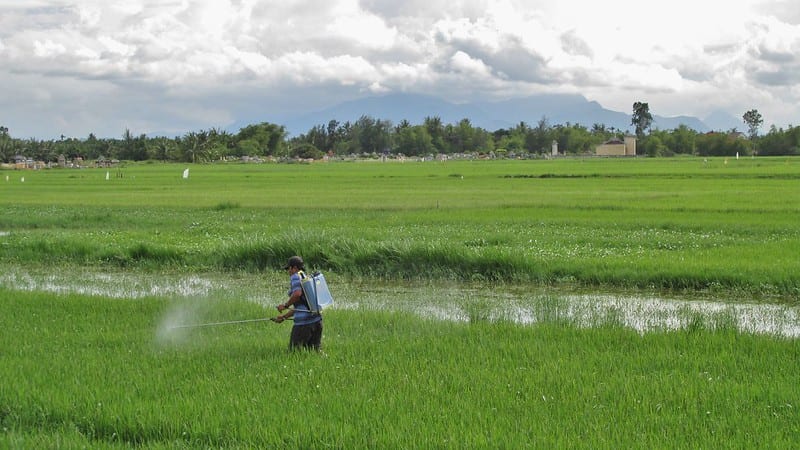Pesticide use has increased substantially around the world in recent decades, as these chemical products have been found in some cases to increase crop yields, and reduce damage from pests or other invasive crops. This increase, however, has been accompanied by growing concerns about the potential impacts of these products on humans and on the environment.
Humans are exposed to pesticides through direct and indirect forms of exposure. Workers handling these chemicals may continue to be exposed to them after they have finished or stopped treating crops, through residue carried into their homes on their clothes and shoes. Workers may also inhale or absorb pesticides through the skin. Children may also come into direct contact with pesticides by finding or handling bottles that have been discarded, but still contain toxic residues, or by ingesting these products accidentally. As fields are often sprayed with pesticides, children may come into contact with these products when they are playing outdoors or in the grass.
 Pesticide residues and traces of pesticides are often found many kilometers away from the sites of pesticide application, contributing to the challenge of containing the damaging properties of these chemicals. Pesticides can seep into the soil around the crops they were applied to, be picked up by the wind and drift into nearby homes and communities, or be washed into nearby waterways, contaminating the water source, and being inadvertently ingested by those people or animals drinking the water. Pesticide residue is often detected as well on food, as traces can remain on food long after the crop itself or surrounding crop was sprayed. Notably, studies have shown that toxins from pesticide exposure can be transmitted from mother to child through breast milk, or from mother to fetus, as these chemicals can cross the placenta and threaten the health of the fetus.
Pesticide residues and traces of pesticides are often found many kilometers away from the sites of pesticide application, contributing to the challenge of containing the damaging properties of these chemicals. Pesticides can seep into the soil around the crops they were applied to, be picked up by the wind and drift into nearby homes and communities, or be washed into nearby waterways, contaminating the water source, and being inadvertently ingested by those people or animals drinking the water. Pesticide residue is often detected as well on food, as traces can remain on food long after the crop itself or surrounding crop was sprayed. Notably, studies have shown that toxins from pesticide exposure can be transmitted from mother to child through breast milk, or from mother to fetus, as these chemicals can cross the placenta and threaten the health of the fetus.
Many stakeholders have voiced concerns about the human rights impacts of the use of pesticides. However, in general, there is a gap between the important advocacy and research carried out by activists at the local level with affected communities, and international human rights discourse. As such, we have produced this guide analyzing pesticide use from human rights perspective in the hope it will be a useful contribution to the debate around these issues and to human rights advocates.
In recent months, successful litigation against pesticide manufacturers has revitalized the possibility of holding corporations and governments to account for the harmful effects of pesticides. In response to the rulings, United Nations experts acknowledged that “unsafe and excessive use of chemicals has negative impacts on a wide range of human rights including rights to life, food, water, health as well as to a healthy environment.” Approaching the problem from a human rights perspective emphasizes the reality that the impact on one or more human rights can create a domino effect. When one human right is negatively impacted, this can threaten the realization of others.
In this context, the O’Neill Institute, jointly with the Due Process of Law Foundation, are developing a guide that focuses on the potential adverse effects of pesticides on human rights, the relevant international and regional human rights standards and the way in which they can be used to protect people, and particularly vulnerable populations from the negative impact of pesticides. The guide should be available online by the end of this year.
Image: garycycles 8 via Flickr



